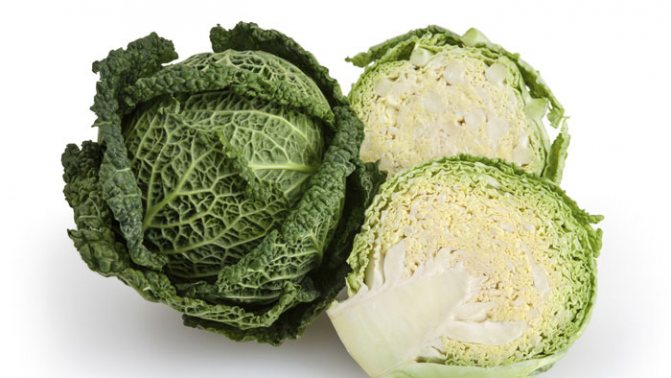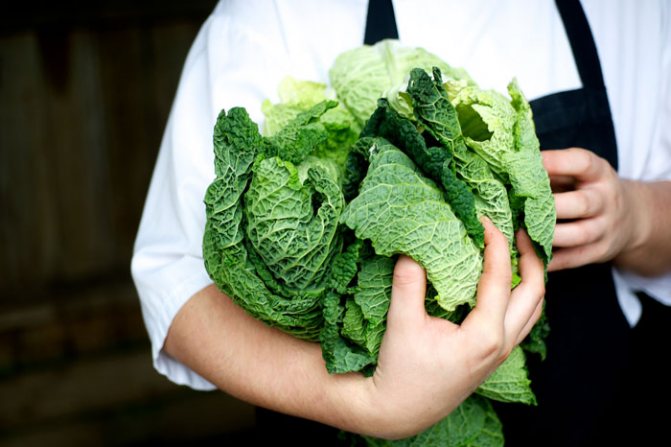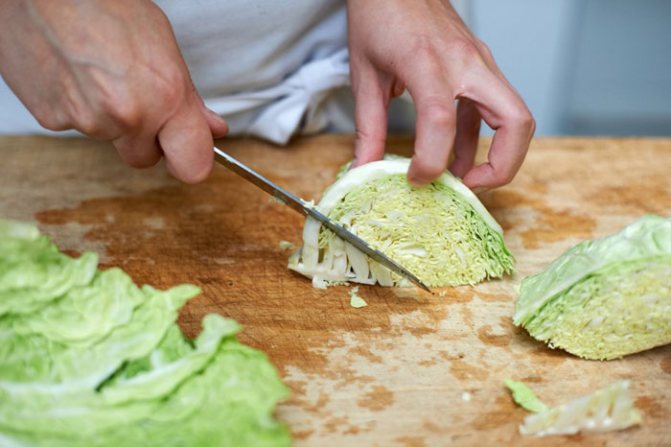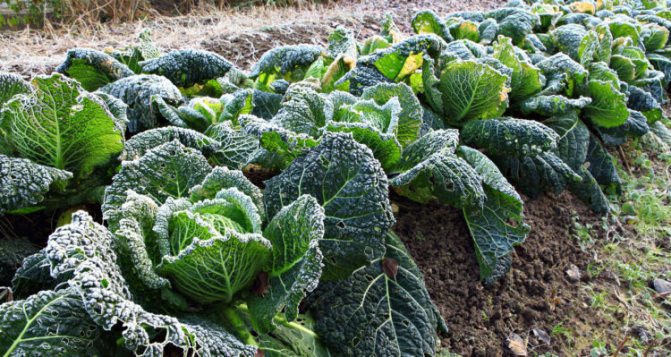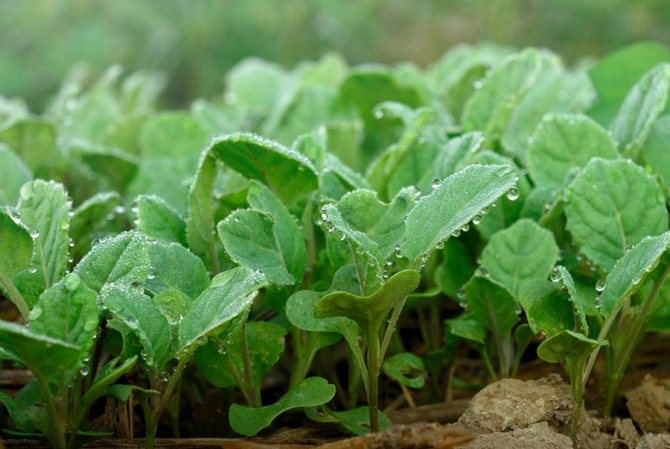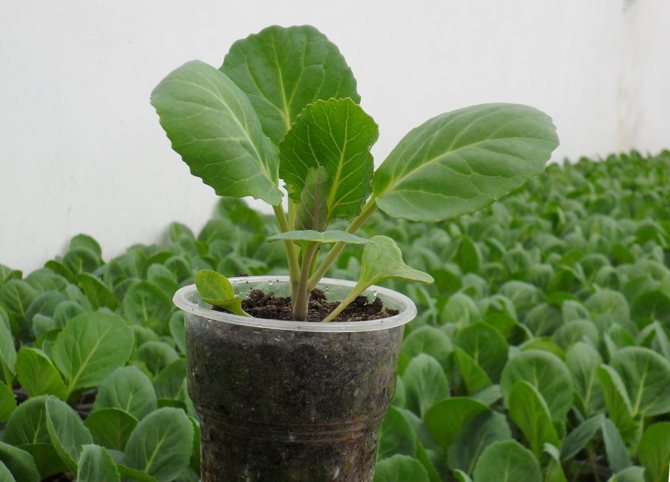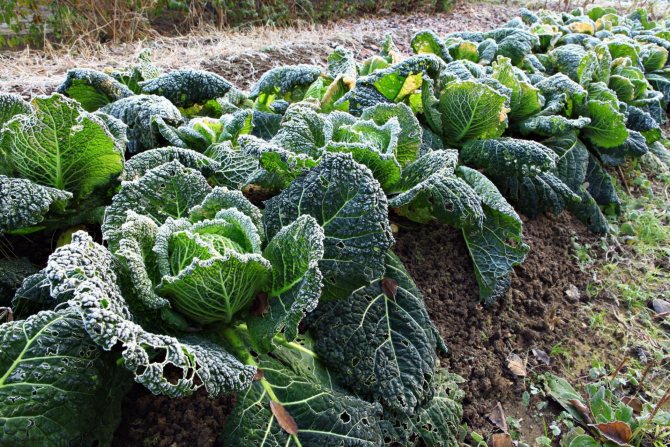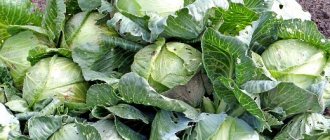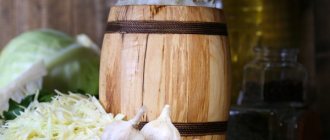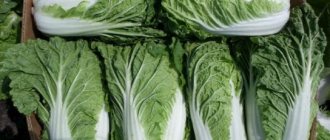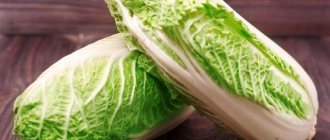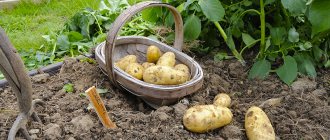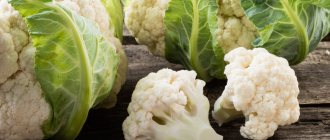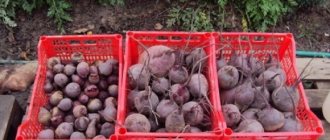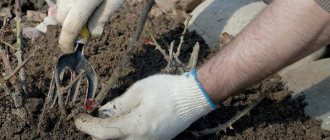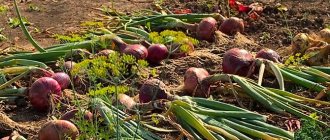Savoy cabbage is a healthy vegetable, unfortunately, not familiar to all gardeners. Outwardly, it is similar to white cabbage and resembles it a little in taste. But by the juiciness and tenderness of the leaves, they cannot be compared! Savoy cabbage makes wonderful fresh vitamin salads that rarely appear on the winter table. You can also cook other dishes from it: stuffing for pies and cabbage rolls, borscht and soups. But if you have only grown a few heads of cabbage, you should not fry or stew them. Leave for fresh salads, from white cabbage they are not so tasty. And how to store Savoy cabbage, we'll talk right now.
Description of varieties
This type of cabbage, like Brussels sprouts, is very rare in the gardens in Russia. Cultivation of cabbage is not much different from the agricultural technique of a white-headed relative. Its limited distribution should be associated with the folk wisdom, which is reflected in the saying: “I don’t need to do what is best, leave me what’s good.”
The State Register of Russia includes 22 varieties, of which 13 are hybrid varieties. The first varieties were included in the register in 1950, two more new varieties were added in 2020: Viratoba and Madeleine. The varieties are not zoned and are grown in all regions of the country. The varieties have different ripeness periods:
- very early ripening (from 90 days): Petrovna, Pirozhkovaya;
- early maturity (105-120 days): Elena F1, Golden early, Moscow lacemaker, Nyusha, Salima F1, Yubileinaya 2170;
- mid-season (120-135 days): Melissa F1, Sphere F1, Uralochka, Extrema F1;
- mid-late: Vertu 1340, Madeleine F1, Ovasa F1, Morama F1;
- late (140 days or more): Alaska, Virotoba F1, Virosa F1, Jade F1, Nadia.
A special feature of Savoy cabbage, in addition to its unusual appearance, is especially delicate leaves. They can be compared to the fragile leaves of Chinese cabbage. Therefore, it is recommended for baby food and for the elderly.

This is a dietary product, its nutritional quality is higher than that of the white-headed variety. The use of this vegetable, according to international medical research, helps the body fight many disorders of the body:
- easily digested and quickly absorbed, facilitating the work of the gastrointestinal tract;
- restores metabolism;
- calms the nervous system;
- strengthens bones;
- normalizes blood pressure;
- renews blood composition;
- stabilizes the work of the heart muscle.
Savoy cabbage is very rich in vitamins, microelements, it is anti-inflammatory, antibacterial, diuretic, antioxidant. With stomach ulcers, gastritis, the use of vegetables should be limited.
Cleaning and storage
Early ripening varieties are harvested when the heads of cabbage become firm. The timing of harvesting late-ripening varieties is chosen depending on whether long-term storage is expected. For winter storage, heads of cabbage must be harvested at a temperature of at least -3 C.
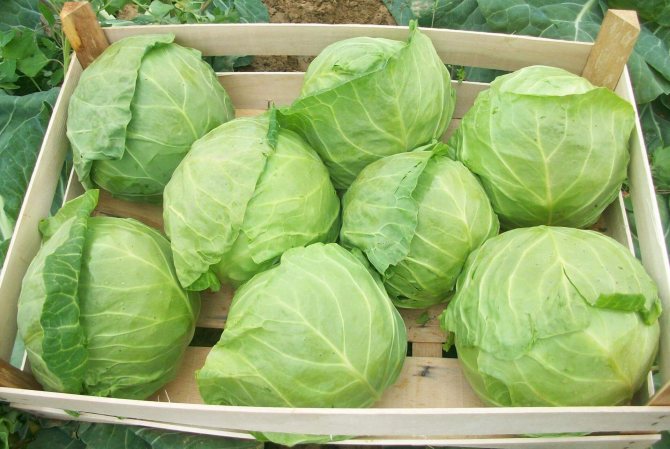

The best way to store cabbage is to put it in wooden boxes, but the cabbages should not touch each other.
It is worth remembering that Savoy cabbage leaves are edible too.
In order for cabbage storage to be successful, you need to follow some rules:
- It is undesirable to water the plant before cutting the heads.
- It is better to cut cabbage in dry weather.
- It is necessary to leave 2-3 sheets of covering leaves on the head of cabbage, which will protect it from external influences.
- Heads of cabbage must weigh at least a pound; the larger the head of cabbage, the better it is stored.
- Only healthy heads of cabbage are suitable for long-term storage: which are not slightly frozen;
- do not have rotten areas;
- not infested with pests or fungal diseases.
Before you put the cabbage for storage, you need to dry it: sprinkle the heads of cabbage with chalk crumbs and spread them for two or three days in a dry room on shelves, preferably trellised ones. You also need to shorten their stumps to two or three centimeters.
Theoretically, you can store Savoy cabbage for up to six months, but many gardeners talk about two to three months' storage at best. Creation of the right conditions plays an important role:
- You need to store the heads of cabbage in wooden boxes, leaving a distance of several centimeters between them.
- The cabbage is stored in the position of the cut stump upwards.
- Storage temperature from 0 to 3 C.
- Air humidity 90–95%
- The storage room should be free of fungus, mold and rodents; it is advisable to treat the basement or cellar with an antiseptic.
You can store Savoy cabbage not only in boxes:
- It is allowed to store heads of cabbage in a grid suspended from the ceiling, while they must be placed separately, with a gap of several centimeters between the grids.
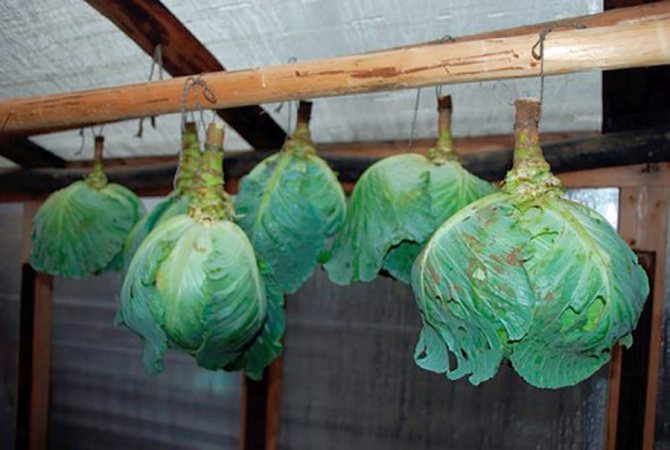

Some keep cabbage hanging not in nets, but by stumps - You can make a pyramid from heads of cabbage and sand. The largest specimens should be placed at its base, which are placed with stumps up. A layer of cabbage must be completely covered with sand, and the next layer is to lay smaller heads of cabbage (they must be placed with stumps down), which are again covered with sand. According to this principle, heads of cabbage are placed to the very top of the pyramid. You can also cover the heads of cabbage with sand in the box.
- Heads of cabbage can be wrapped in cling film or a thick layer of paper.
Video: Savoy cabbage is a worthy competitor to white cabbage
Planting seeds
Cultivation of savoy cabbage is possible by seedling and non-seedling methods. Seedlings are needed to extend the growing season. The seedless method is used to harvest medium-ripening cabbage in the south of the country. When planting seedlessly, seeds are sown in greenhouses or on a protected bed.
Early vegetables are sown at the beginning of the first spring month, in March, late varieties - in early April, medium ripening - in mid-April.
Although seedlings appear at + 3-5 ° C, a temperature suitable for plant development is + 12-18 ° C during the day and +2 ° C at night.
Seed preparation for sowing consists in passing the following procedures:
- separation of viable seeds in salted water;
- warming up in hot water for disinfection;
- keeping trace elements in solution;
- cooling for a day in the refrigerator;
- drying before disembarking.
The prepared soil mixture should be loose, nutritious, moisture and breathable. Mix peat, sand or moss, earth in equal parts. Land is not taken from the greenhouse and from the garden.
In the planting box, grooves are made every 3 cm and a depth of 1 cm, spilled with a weak solution of potassium permanganate and the seeds are laid out at a distance of 1 cm from each other. The crops are covered with glass to retain moisture.
Seedlings appear on the second or third day. Glass is removed from them, transferred to a bright room. The temperature in the first seven days drops to + 6-10 ° C. During this time, the seedlings feed on the seed and grow roots. Then the temperature is raised again to + 12-18 ° C.
Growing seedlings
Early varieties are suitable for cultivating the first harvest in June, which are provided with sufficient light, watering and nutrition.
There are no special secrets about how to grow savoy cabbage.Her agricultural technology is the same as that of a white-headed relative. Food and water are the main requirements for the normal development of seedlings.
Illumination at the beginning of growth should be at least 12 hours. At home, artificial lighting is used to grow early varieties. Cabbage is a long day plant. An adult plant does not require light.
The temperature for optimal plant development is + 15-18 ° С.
Watering is necessary for the plant throughout the growing season. Cabbage has superficial fibrous roots and very large leaves that evaporate a lot of moisture. Watering is especially important during the development of young plants and during the setting of heads. Intensive growth of the vegetable is observed only at 90% soil moisture.


When cultivating seedlings in cassettes or individual pots, it does not outgrow, it receives enough light, it takes root better during transshipment, and gives a leveled yield. Seeds and land are significantly saved. For industrial plantings, it is grown only in this way.
If the seedlings grow in a large seedling box, then a few days after the seedlings appear, they must be cut into separate cups. When transplanting, the roots are shortened, cutting them by 1/3 part, the seedling is buried to the first leaves.
The first feeding is done a week after planting. It is needed to stimulate the development of the root system.
If the seedlings are strong and healthy, then no additional feeding is done. With a weak, elongated seedlings continue to feed every 7-10 days. Nutrition is important for seedlings, as the consumption of essential elements from the soil is highest during this period of growth.
Seedlings quickly recycle food from the small volume of soil in which they are located. To prevent the plant from suffering from nutritional deficiencies, fertilizing is carried out 2-4 times.
Seedlings grown in cassettes are fed twice:
- After 2 leaves appear.
- Before hardening.
Seedlings that need picking are fed four times.
Liquid dressings are most fully assimilated. The first subcortex is done when two leaves appear. At this time, it is better to feed with a solution of micronutrient fertilizers:
- NPK + micro;
- "Humat";
- Ultramag;
- "Activin";
- Valagro.
For this, natural remedies are suitable:
- infusion of ash;
- eggshell infusion;
- water after washing meat or fish.
Chemicals are also suitable:
- superphosphate;
- urea;
- potassium sulfate.
You can use humate preparations, solutions of trace elements and microbiological preparations. For example, "Fitosporin-M" and "Gumi" not only feed the plants, but also protect against the "black leg" and other fungal infections.
The second feeding is carried out after planting. If the pick is not done, then the second feeding is done before hardening. At this time, it is effective to use an aqueous mineral solution of fertilizers.
Before hardening, a tablespoon of urea or potassium sulfate is stirred in a bucket and poured into a glass under each plant.
Important! Top dressing is carried out only after watering the plants.
Hardening is a necessary procedure before transferring to the garden. It is needed for a painless move to the beds. For 2 weeks, the seedlings are accustomed to the outside temperature. To do this, they put it in the yard for several hours, increasing the time every day.
A few days before transshipment, the last feeding is done. To do this, dissolve a teaspoon of superphosphate, ammonium nitrate and nitrophoska in a bucket of water.
How to plant Savoy cabbage outdoors can be understood from the experience of growing its white cabbage variety. Standard seedlings are ready 45 days after sowing. She should have 4-6 true leaves, strong stem, height 20-25 cm.
Seeds
The technology of growing Savoy cabbage from seeds is practically no different from the method of growing white cabbage.
The most important thing that young sprouts need is timely watering.... If you follow the instructions, you can get good seedlings, and in the future - a rich harvest.
You can buy savoy cabbage seeds at any specialty store or order them online.
The cost of one packet is about 40 rubles. The variety should be chosen based on your needs and taste preferences.
Outdoor care
Savoy cabbage thrives outdoors. It is planted in the garden in mid-May. Planting depth - up to cotyledon leaves.
Preparation of the soil for the garden begins in the fall of the previous year. The soil should be loose, fertile, with a neutral reaction. Fill the soil with manure, ash, humus. Cabbage is the first crop to be planted after applying manure.


In the spring, you can also take up the land for cabbage beds. But manure is no longer added, the soil is filled with mineral fertilizers: superphosphate, urea, ammonium nitrate.
Barren sandy and clayey soils are not suitable for the development of this vegetable.
The planting scheme for early varieties is 50x40 cm, for later varieties - 50x50 cm. This is a very cold-resistant culture. In the open field, she feels great even in Siberia. In the southern regions of Russia, it winters in open beds at -8 ° C.
Cabbage is planted in holes 10 cm deep. Before and after transfer, the holes are well spilled with water, at least 1.5 liters of water are poured into each.
This is a light-loving culture. It is advisable to plant in open beds, without shade. Grows well on southern slopes. After planting seedlings in the beds, they are darkened until it takes root.
The culture is demanding on moisture, but does not tolerate waterlogging. In the early days, seedlings are watered daily, an adult plant - once a week, but very abundantly.
When sprinkling, drops of moisture roll off the waxy leaves of white cabbage, on the bubbly leaves of Savoy, on the contrary, it lingers for a long time.
Important! To prevent the heads of cabbage from cracking, it is necessary to water only at the root.
The vegetable is demanding for nutrients. Top dressing is done when planting in the ground and when tying heads of cabbage. To do this, apply:
- mullein solution;
- infusion of ash or weeds;
- superphosphate solutions; urea;
- nitrophoski;
- yeast;
- boric acid.
The vegetable quickly accumulates excess fertilizer in the form of nitrates. Therefore, unnecessary dressings with solutions of increased concentration should not be done.
Observance of crop rotation is imperative, one cannot but plant Savoy cabbage after plants of the same family. Best predecessors:
- roots;
- legumes;
- cucumbers;
- tomatoes.
Three weeks after transshipment into open ground, the ridges are weeded from weeds and the stems are spud. The trunk in the ground gives additional roots, increasing the feeding area. Proper care allows you to get healthy plants with a rich harvest.
Is it possible to salt savoy cabbage for the winter
It is believed that salting a vegetable for the winter is impossible because of the delicate leaves, which creep and lose their crunch. The reason for this problem lies in the wrong choice and preparation of ingredients or an unsuccessful recipe. If all the nuances of the preparation are observed, the winter salad will delight you with an amazing taste..
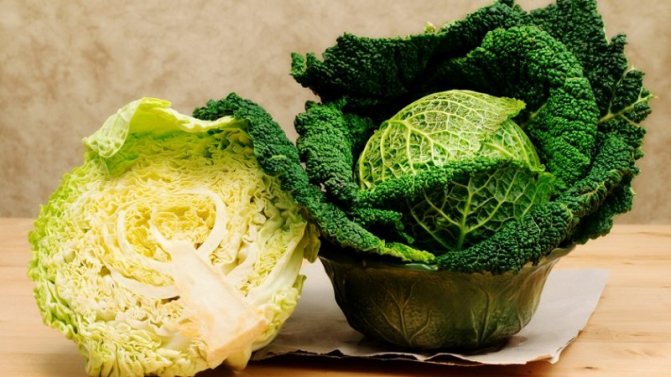

Before choosing a recipe, it is important to understand the cooking technology. When salted, vegetables are in a salt solution concentration of 10% and higher. This leads to the death of most microorganisms.
Fermentation is based on the fermentation of products.caused by the action of special microorganisms. In this case, the salt enhances the taste.
When pickling, vegetables are poured with brine, which contains a preservative, usually vinegar. Salt doesn't really matter here either.
Advantages and disadvantages of salting
Salting is a common way of preparing vegetables for the winter.... Its main advantages:
- Vinegar and other preservatives are not added to the jars, so this preparation is allowed even for children.
- When preserving with salt, heat treatment is often not used. The structure of nutrients is not disturbed, vegetables retain vitamins and minerals.
- The cabbage stays crisp and doesn't fall apart.
- Vegetables emit a lot of juice, in which they are preserved and acquire a new, special taste.


Like all preservation methods, salting has its drawbacks:
- Due to the large amount of salt, such products are contraindicated in hypertension, kidney disease.
- In comparison with pickled cabbage canned in vinegar, it is not stored for long - no more than 8 months.
Take a note:
Features of pickling cucumbers for the winter in a barrel
How to properly pickle onions for the winter in jars
Methods for salting red cabbage for the winter

